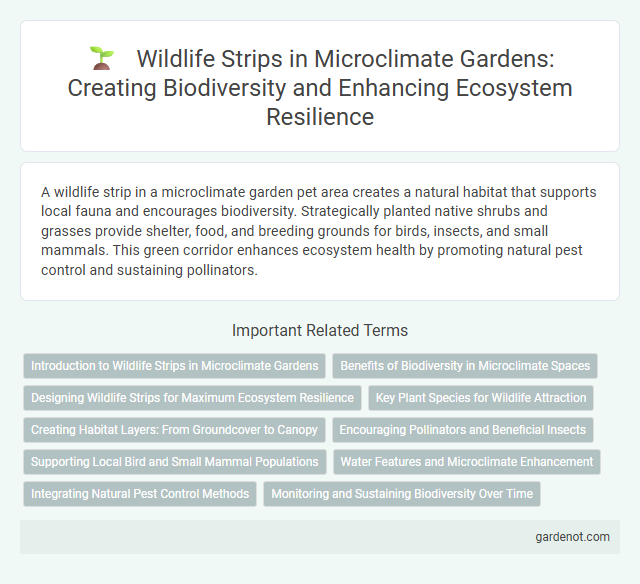A wildlife strip in a microclimate garden pet area creates a natural habitat that supports local fauna and encourages biodiversity. Strategically planted native shrubs and grasses provide shelter, food, and breeding grounds for birds, insects, and small mammals. This green corridor enhances ecosystem health by promoting natural pest control and sustaining pollinators.
Introduction to Wildlife Strips in Microclimate Gardens
Wildlife strips in microclimate gardens are specifically designed narrow zones that enhance biodiversity by providing habitat and resources for native pollinators, insects, and small animals. These strips create favorable microhabitats that regulate temperature and moisture, promoting ecological balance and supporting plant resilience. Integrating wildlife strips increases beneficial species presence, improving natural pest control and pollination within garden ecosystems.
Benefits of Biodiversity in Microclimate Spaces
Wildlife strips in microclimate gardens enhance biodiversity by providing essential habitats for pollinators, birds, and beneficial insects, supporting ecosystem balance. These natural corridors improve soil health and plant resilience, contributing to microclimate regulation through increased shade and moisture retention. Higher biodiversity within these strips promotes pest control and aids in maintaining stable temperature conditions, optimizing garden productivity and sustainability.
Designing Wildlife Strips for Maximum Ecosystem Resilience
Designing wildlife strips involves selecting native plant species that provide continuous blooms and diverse habitats to support pollinators, birds, and beneficial insects throughout the year. Incorporating layered vegetation structures enhances shelter and food availability, promoting species richness and ecological connectivity within the microclimate garden. Proper placement along water sources and migration paths increases ecosystem resilience by facilitating natural wildlife movement and habitat corridors.
Key Plant Species for Wildlife Attraction
Key plant species for wildlife attraction in a microclimate garden include milkweed (Asclepias spp.), essential for monarch butterflies, and native wildflowers like black-eyed Susan (Rudbeckia hirta). Shrubs such as elderberry (Sambucus canadensis) provide shelter and food for birds, while native grasses like little bluestem (Schizachyrium scoparium) create habitat for pollinators and small mammals. Incorporating these species enhances biodiversity and supports local ecosystem balance in wildlife strips.
Creating Habitat Layers: From Groundcover to Canopy
Creating habitat layers in a microclimate garden enhances biodiversity by incorporating diverse vegetation from groundcover to canopy. Groundcover plants provide shelter and foraging opportunities for insects and small animals, while shrubs and understory plants support birds and pollinators. Canopy trees offer nesting sites and shade, regulating temperature and moisture to create a balanced ecosystem.
Encouraging Pollinators and Beneficial Insects
Wildlife strips in microclimate gardens create vital habitats that attract pollinators such as bees, butterflies, and beneficial insects like ladybugs and lacewings. Planting native flowering species with staggered bloom times maximizes nectar and pollen availability, supporting diverse insect populations year-round. These strips enhance pollination efficiency and natural pest control, promoting ecological balance and healthier garden ecosystems.
Supporting Local Bird and Small Mammal Populations
A wildlife strip in a microclimate garden provides essential habitat resources that support local bird and small mammal populations by offering food, shelter, and nesting sites. Native plants within the strip create a stable microhabitat that enhances biodiversity and encourages natural foraging behaviors. Establishing these corridors promotes ecological balance and helps maintain population health in urban and suburban environments.
Water Features and Microclimate Enhancement
Water features in a wildlife strip significantly enhance microclimate conditions by increasing local humidity and moderating temperature fluctuations, creating a more favorable environment for native plants and animals. The presence of ponds or streams supports amphibians, insects, and birds, promoting biodiversity while also aiding in soil moisture retention. Integrating water elements fosters a balanced ecosystem, improving air quality and encouraging natural cooling effects within the microclimate garden.
Integrating Natural Pest Control Methods
Wildlife strips in microclimate gardens serve as essential habitats for beneficial insects like ladybugs, lacewings, and predatory beetles that naturally control pest populations. Incorporating native flowering plants and diverse vegetation in these strips enhances biological pest suppression by attracting and sustaining these natural predators. This integration reduces the need for chemical pesticides, promoting ecological balance and supporting pollinator health within the garden ecosystem.
Monitoring and Sustaining Biodiversity Over Time
Implementing wildlife strips in microclimate gardens enhances habitat connectivity and supports diverse species populations essential for ecological resilience. Continuous monitoring through species inventories, camera traps, and bioacoustic sensors provides critical data to assess the effectiveness of these strips in sustaining native wildlife. Adaptive management strategies informed by long-term biodiversity trends ensure the preservation and enrichment of local ecosystems.
Wildlife strip Infographic

 gardenot.com
gardenot.com